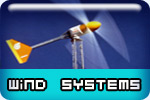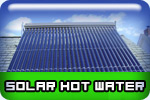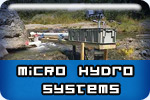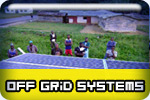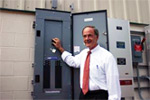Wind Energy – Another Gift from the Sun?
Wind energy comes from the sun. It is true – wind energy is simply a converted form of solar energy! The sun’s radiation warms different parts of the earth, oceans, and other bodies of water, at different rates. The night and day cycles make an obvious difference, but also, water and land absorb or reflect sunlight differently. The result of this uneven heating is atmospheric change. Hot air rises, leaving decreased atmospheric pressure near the earth’s surface, and cool air is drawn in to replace it. The result of this air exchange is wind.
Understanding the underlying source of wind helps to explain why wind sometimes varies significantly in microclimates – in other words, it is often site specific. Your house on a hill might get lots of wind, yet your neighbor only forty yards away, downhill from you, might get very little. Wind resources are typically best along coastlines, on hilltops, and at northern latitudes.
While wind might not be as widely available, in as many sites, as solar energy is, it does have some great benefits if you happen to have good localized wind resources. Wind energy tends to be more prevalent in the winter months, and during inclement weather. This is an advantageous arrangement for those with solar electric (PV) systems; when sunlight is scarce, this wind is making electricity. A hybrid system, combining wind and PV solar production, will produce the most electricity on average, year round.
How it Works – Getting Acquainted with a Wind Turbine
Air has mass, and when it is in motion (wind), it contains kinetic energy. Wind turbines powered by this energy of motion convert it into mechanical energy, and the mechanical energy can be used to create electricity.
Wind turbines, then, are energy conversion devices. Most people can call to mind the image of an old wind powered mill used for centuries in the Netherlands, and Spain; their giant sails, slowly rotating, doing the heavy mechanical work of grinding grain, or pumping water. While wind energy has long been used for such work, it is only recently that wind turbines have been used to generate electricity.
Modern turbines come in two basic varieties. There are those with a vertical axis – which rather resembles a giant eggbeater, and there are those with a horizontal axis, which resembles a propeller. The vast majority of wind turbines in use today are of the propeller style. Wise Power Systems’ small wind installations use the propeller type turbines.
The primary components in a small wind turbine system include:
The rotor – consists of two or more propeller-like blades fused to a cap unit that is tied to a rotating shaft. The force of the wind turns the blades, which transfer the energy into a rotating shaft, which in turn spins a generator to produce electricity.
The Nacelle – is the enclosed body of the turbine. It houses the moving parts – a drive train, gearbox and generator, or a magnetic alternator and gear-less direct drive generator – where the mechanical energy is converted into electricity.
The Mainframe – is the structural skeleton that contains the ‘slip ring’, which connects the nacelle and its wiring to the tower, in such a way that the rotor can spin freely and face into the wind.
The Tail – Has a fin and helps align the rotor into the prevailing wind. Tails are typical on small wind turbines, but are not found on most large (utility sized) turbines.
The Tower – supports the rotor and nacelle. It elevates the turbine in order to increase exposure to higher velocities of wind, with less localized (obstacle based) turbulence than locations nearer the ground.
The Inverter – similar to the inverter used in solar electric systems, this device converts the D/C electricity generated by the system, to A/C electricity commonly used in homes and businesses. Typically, the system’s inverter has a built-in digital monitor, as well.
Power Disconnect Devices – again, like the solar electric system, the small wind system includes both a D/C, and an A/C disconnect device – to interrupt the electricity supply, as a safety over-ride.
Electric Cables – Transport the electricity from the generator to the electrical panel, batteries, and/or grid.
Indoor System Monitor (optional) – Makes monitoring system performance more convenient than it is when checking the inverter monitor (outdoors).
Batteries (optional) – As mentioned in the Solar Basics section of this site, battery back-up is useful in some situations, but most people opt for a utility grid-intertied system, instead of investing in their own battery system. Do to the expense of compatible batteries; they are most suitable for smaller wattage systems.
Charge Control Device – Only used in battery-tied systems. This prevents the over-charge of the batteries.
Wind Power System Options: (See the Solar Basics Page for Additional System Description)
Grid Inter-tied – This is the first choice of most customers, since it allows the flexibility of using the grid like a battery and as an alternate power source, and may carry financial incentives that are grid-tied system specific.
Battery Back-up Systems – Batteries can be used in conjunction with a grid-tied system, for emergency supply during power outages, or in place of a grid connection.
Stand Alone Systems – Typically these include battery components. They are typically only used in remote locations with no access to a utility power grid.
How Large is the Turbine, and How Much Energy Will it Produce?
Wind turbines are available in a wide variety of sizes. Most micro- or small wind systems are sized with rotors ranging in size from a little over five feet to about fifteen feet in diameter. Larger turbines are used on large farms, and for utility power production.
Wise Power Systems Wind Installations can include one or more turbines sized and rated for 500 watts of power production, up to 10 kilowatts of production. These small wind systems are typically mounted on towers of 50 feet or less, and in certain circumstances, the micro-turbines can be roof mounted, singly, or in groups. An unobstructed area, with a lot size of one acre or more is preferable for most systems with towers.
Both wind speed, and wind force (the energy that a turbine converts to electricity) tend to be greater at higher altitudes. Surprisingly, though, the relationship between the two is not a linear one (mathematically speaking). The force of wind increases as the cube of wind speed. That means that a twenty mph wind speed will generate eight times more wind force than a ten mph wind speed will. (Example: 10x10x10=1000 while 20x20x20=8000. 8000 ÷1000 = 8). What does this mean? The higher a turbine is mounted, the more wind force it will have to convert into electricity!
Determining the most efficient system size to meet your energy needs is more complex with wind resources, than it is with solar energy systems. A Wise Power Systems consultant can help you with this assessment. To begin, you can factor your current energy consumption, and needs. Next, you can surmise whether or not there is an obvious wind resource at your location – An average of at least eight miles per hour of wind speed is recommended to make a small wind system cost-effective. There is helpful assessment information on the Tools and Resources page of this site.


